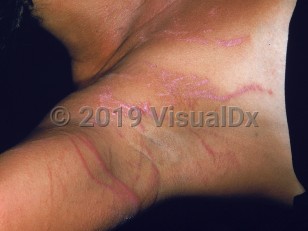Portuguese man-of-war sting in Child
Alerts and Notices
Important News & Links
Synopsis

The Atlantic Portuguese man-of-war, Physalia physalis, and the smaller Pacific bluebottle, Physalia utriculus, are not true jellyfish but rather a colony of organisms. Both species have a floating air bladder (pneumatophore) and tentacles with stinging cells (nematocysts) that are used to paralyze prey. The Portuguese man-of-war has a 25 cm (10 inch) long float and trails many tentacles up to 30 meters (100 feet) long, whereas the smaller bluebottle has a float 10 cm (4 inches) long and only one main tentacle that is up to 3 meters (10 feet) long. Each tentacle carries hundreds of thousands of nematocysts, and even when detached from the jellyfish can sting for weeks to months after separation.
The Portuguese man-of-war is found in the Atlantic Ocean from Nova Scotia to the Caribbean, and an Australian version is present in north Australian waters. The bluebottle is found in the tropical to temperate waters of the Pacific and Indian Oceans.
Physalia venom is cytotoxic, causes release of inflammatory mediators, and is directly toxic to the myocardium, liver, and kidneys. One toxin, physalitoxin, depresses the nervous system and causes respiratory depression.
Contact with Physalia tentacles results in immediate, sharp, stinging pain followed by a severe ache that can spread to joints and lymph nodes. Duration of pain can last minutes to hours. At the sting site, a red line with scattered papules rapidly develops. Sometimes, wheals and blisters form. The wheals last a few hours, while the redness can last up to 24 hours. Portuguese man-of-war stings are more painful than most jellyfish stings. If the eye is affected, there may be intense burning and tearing pain, blurry vision, and light sensitivity with spontaneous resolution in 24-48 hours.
Systemic reactions are common but are rarely severe. Symptoms can involve all major organ systems. Mild shock, nausea, vomiting, abdominal pain, muscle cramps, and headache are common. Death is rare and is from cardiovascular collapse or respiratory arrest. An Irukandji-like syndrome has been reported with some Physalia stings.
Hypersensitivity reactions including anaphylaxis are rare in jellyfish envenomations.
The Portuguese man-of-war is found in the Atlantic Ocean from Nova Scotia to the Caribbean, and an Australian version is present in north Australian waters. The bluebottle is found in the tropical to temperate waters of the Pacific and Indian Oceans.
Physalia venom is cytotoxic, causes release of inflammatory mediators, and is directly toxic to the myocardium, liver, and kidneys. One toxin, physalitoxin, depresses the nervous system and causes respiratory depression.
Contact with Physalia tentacles results in immediate, sharp, stinging pain followed by a severe ache that can spread to joints and lymph nodes. Duration of pain can last minutes to hours. At the sting site, a red line with scattered papules rapidly develops. Sometimes, wheals and blisters form. The wheals last a few hours, while the redness can last up to 24 hours. Portuguese man-of-war stings are more painful than most jellyfish stings. If the eye is affected, there may be intense burning and tearing pain, blurry vision, and light sensitivity with spontaneous resolution in 24-48 hours.
Systemic reactions are common but are rarely severe. Symptoms can involve all major organ systems. Mild shock, nausea, vomiting, abdominal pain, muscle cramps, and headache are common. Death is rare and is from cardiovascular collapse or respiratory arrest. An Irukandji-like syndrome has been reported with some Physalia stings.
Hypersensitivity reactions including anaphylaxis are rare in jellyfish envenomations.
Codes
ICD10CM:
T63.611A – Toxic effect of contact with Portuguese Man-o-war, accidental (unintentional), initial encounter
SNOMEDCT:
242602004 – Stung by Portuguese Man-of-war
T63.611A – Toxic effect of contact with Portuguese Man-o-war, accidental (unintentional), initial encounter
SNOMEDCT:
242602004 – Stung by Portuguese Man-of-war
Look For
Subscription Required
Diagnostic Pearls
Subscription Required
Differential Diagnosis & Pitfalls

To perform a comparison, select diagnoses from the classic differential
Subscription Required
Best Tests
Subscription Required
Management Pearls
Subscription Required
Therapy
Subscription Required
References
Subscription Required
Last Updated:05/26/2020
 Patient Information for Portuguese man-of-war sting in Child
Patient Information for Portuguese man-of-war sting in Child
Premium Feature
VisualDx Patient Handouts
Available in the Elite package
- Improve treatment compliance
- Reduce after-hours questions
- Increase patient engagement and satisfaction
- Written in clear, easy-to-understand language. No confusing jargon.
- Available in English and Spanish
- Print out or email directly to your patient
Upgrade Today


